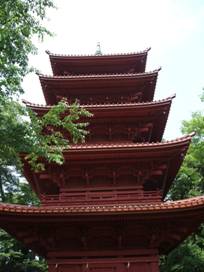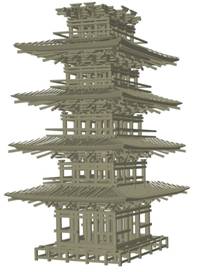Tokyo, December 4, 2008 – Digital Reconstruction Project Attempt to Reveal Secrets of Earthquake-Resistant Frame Construction
 The 30 meter high, five-story scarlet stupa graces the grounds of the Hokekyo Temple of the Buddhist Nichiren-sect in Chiba Prefecture, Japan. Built in 1622, it is the only 5-story stupa in Chiba and a designated “national cultural property.” The wooden structure has survived 400 years of varied weather conditions and earthquakes, and is still visited by worshipers.
The 30 meter high, five-story scarlet stupa graces the grounds of the Hokekyo Temple of the Buddhist Nichiren-sect in Chiba Prefecture, Japan. Built in 1622, it is the only 5-story stupa in Chiba and a designated “national cultural property.” The wooden structure has survived 400 years of varied weather conditions and earthquakes, and is still visited by worshipers.
Originating in India, the stupa tradition eventually spread to China and Japan. Significantly, there is no recorded report of a collapsed stupa in the earthquake-prone country.
A Chiba University research team, headed by Engineering Professor Hirasawa, is untangling the secret of a historic stupa structure, using computer technology and mathematical analysis to create a 3D model.
Hirasawa praises the versatility of Archicad’s GDL (Geometric Description Language) used to create the project’s 3D model.
“There are a number of computer graphic software one could use to model in 3D, but it is difficult to change the attributes. GDL makes it easy to change lengths, thicknesses, and conditions of the curved surfaces by modifying the parameters. Moreover, creating elements with numerical calculation in GDL ensures that the model can be recreated in real life.”
In addition to studying the stupa’s original documents, the team is using the computer vision method to calculate the stupa elements themselves. This involves photographing the parts, adding markers called visual tags, and then making the correct measurement from the pictures.